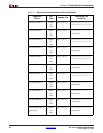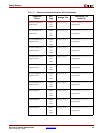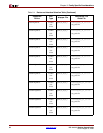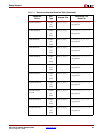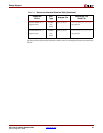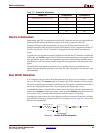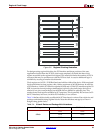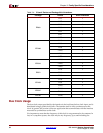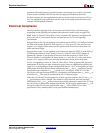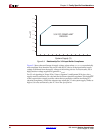
30 www.xilinx.com PCI v3.0.151 Getting Started Guide
UG157 August 31, 2005
Chapter 3: Family Specific Considerations
R
Although this technique is not technically compliant with the PCI specification due to the
extra loading on REQ64# and RST#, the use of a large series resistor helps minimize this
effect. The inverter may be pushed into the FPGA.
An alternate method is to push the entire circuit into the FPGA and use the REQ64Q_N and
RST signals provided to the user application. This method requires that the FPGA be fully
configured by the rising edge of RST#.
When SLOT64 is deasserted, the PCI64 interface automatically three-states the 64-bit
extension signals. In this situation, the 64-bit extension signals are undriven, which may
result in additional power consumption by the input buffers.
If the additional power consumption is of concern due to design requirements, consider
changing the “Disabled Extension Drive” option in the HDL configuration file. This
option, when enabled, forces the PCI64 interface to actively drive the extension signals
when SLOT64 is deasserted.
Note: Although this option may reduce power consumption, it creates an electrically
objectionable situation. When a 64-bit card is installed in a 32-bit slot, the 64-bit bus
extension is floating in free space and unprotected from roaming screwdrivers.
Datapath Output Clock Enable
The PCI interface targeting Virtex devices uses one of the following methods to generate
and distribute the datapath output clock enable signal:
• Specialized device resources: the PCIIOBs, PCILOGIC, and PCI_CE
• Generic device resources: IOBs, LUTs, and general purpose routing
The specialized device resources offer higher and more predictable performance.
However, they constrain the PCI interface to the left or right sides of the FPGA device, and
limit the number of PCI interface instances to two. The generic device resources, while
lower performance and less predictable, offer greater flexibility.
To summarize, the generic device resources must be used in the following cases:
• When the target device is Virtex-II, Virtex-II Pro, Virtex-4, or Spartan-3
• Where more than two instances of the interface are required
• When the interface cannot be located on the left or right side
To disable the use of specialized device resources, edit the HDL configuration file and set
the CFG[251] bit to logic one. You must set CFG[251] to logic one to target a Virtex-II,
Virtex-II Pro, Virtex-4, or Spartan-3 device. Use of this option with other devices is not
supported, and is incompatible with the provided constraint and guide files.
Input Delay Buffers
Input delay buffers are used to provide guaranteed hold time on all bus inputs. Where
possible, the PCI interface targeting Virtex devices uses input delay elements present in the



